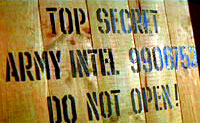The Appeal and Frustration of Ambiguous Movie Endings
Posted on November 1, 2011 at 8:00 am
I like Ann Hornaday’s piece in the Washington Post about ambiguous endings.
In “The Film Snob’s Dictionary,” writers David Kamp and Lawrence Levi cheekily chart out the differences between Movies and Films (“It’s a Movie if it’s black-and-white because it’s old. It’s a Film if it’s black-and-white because it’s Jarmuschy.”) They might have added another definition: It’s a Movie if it ends. It’s a Film if it stops.
Studio films tend to spell everything out — motivations, backstories — while independent films invite the audience to fill in the blanks or just ponder the unanswerable. One reason for that is money. Studio films are expensive and have to appeal to the broadest possible audience. The more money you spend, the more people weigh in on the film’s artistic choices, and the more people weigh in, generally speaking, the more questions get answered on screen.
 Of course, even the most definitive-appearing ending leaves a lot open for discussion. Does finding out what “Rosebud” means in “Citizen Kane answer a question or raise a dozen more? What happens after Rhett tells Scarlett he does not give a damn what happens to her? Does anyone ever open that crate in the government warehouse and find the Lost Ark of the Covenant? What exactly does “happily ever after” mean?
Of course, even the most definitive-appearing ending leaves a lot open for discussion. Does finding out what “Rosebud” means in “Citizen Kane answer a question or raise a dozen more? What happens after Rhett tells Scarlett he does not give a damn what happens to her? Does anyone ever open that crate in the government warehouse and find the Lost Ark of the Covenant? What exactly does “happily ever after” mean?
Hornaday discusses some of this year’s most open-ended movies, including “Take Shelter,” “Martha Marcy May Marlene,” and “Meek’s Cutoff.” I love to come out of a movie and talk about what I think happens next, don’t you? Do you have a favorite theory about an ambiguous ending?

There are a lot of movies where the ending is “open”, but where the story being told does not end “ambiguously”. Some examples (SPOILERS):
> George Clooney is left staring at an enormous airline departure board at the end of “Up in the Air”. The story has ended unambiguously, but where the character goes from here is open.
> What happens to Ben and Elaine after they ride off in the bus at the end of “The Graduate”? Again, the story is open, but has ended unambiguously. (Then again, someone will go and try to answer that question, and you end up with “Rumor Has It”).
I’m not sure at what point in the 50’s or 60’s that the use of a “The End” graphic at the end of a movie fell into disuse – it’s rare enough that the last movie I can remember using it was “A Few Good Men” (Rob Reiner told interviewers he specifically wanted to use it.)
For recent movies, the ambiguous ending of “Inception” sent me back to see it twice. (I won’t tell you my conclusion, but notice the clothing DiCaprio’s children are wearing – and that they haven’t aged.)
Kevin L: great list! And James C.: that was my reaction, too. I hope he made it.
My family spent a long time discussing the ending of “Inception”. We all WANTED DiCaprio to return to his family, but that top never actually fell…